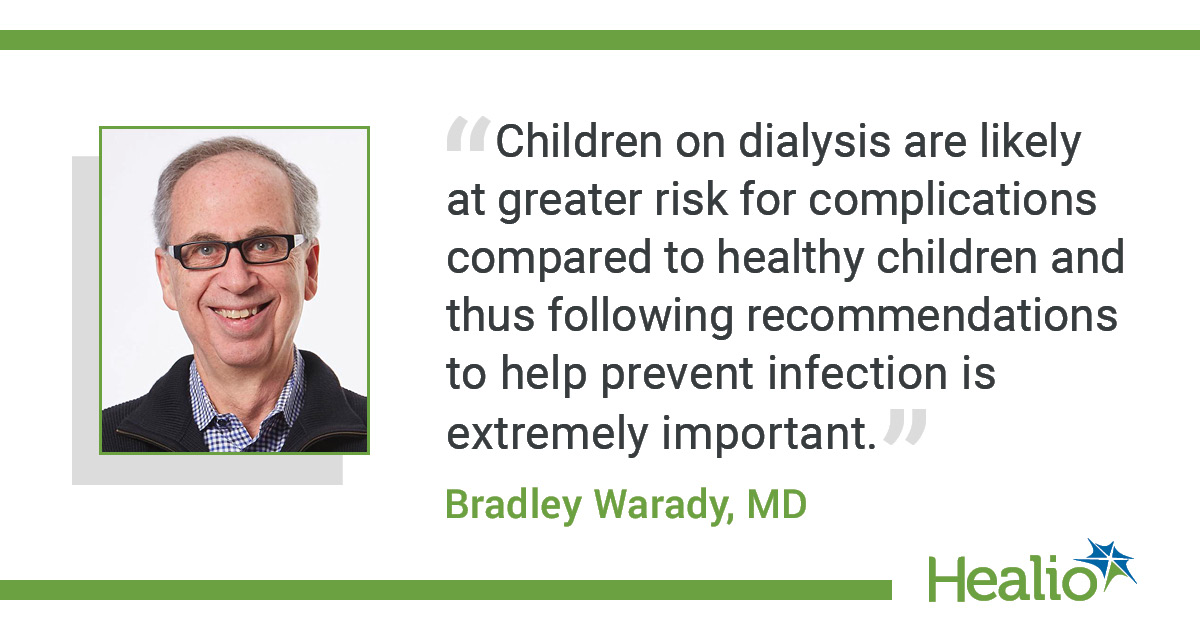Experts release guidance on caring for pediatric patients on dialysis during COVID-19 pandemic

Nephrologists from around the globe — and primarily from China as this is where the virus originated — have developed a set of recommendations for the care of pediatric patients undergoing either in-center or home dialysis during the COVID-19 pandemic.
The guidance, recently published in Pediatric Nephrology, is based on “epidemiological features” of the severe acute respiratory syndrome coronavirus 2 [SARS-CoV-2 virus] and COVID-19 disease.
According to the researchers, pediatric patients with kidney failure “are at significant risk for experiencing infectious diseases such as COVID-19 because of their compromised immune system and their frequent exposure to the hospital setting.” The recommendations are related to susceptibility factors, as well as to preventive and control strategies.
Bradley A. Warady, MD, of the division of pediatric nephrology at Children’s Mercy Kansas City, told Healio Nephrology the recommendations are based upon the clinical experience in China and are similar to those which have been released for adult patients.
He said the recommendations are “directed at both the patients and the parents of these children, in addition to the in-center [hemodialysis] HD staff.”
Prefacing the guidelines, the researchers suggested several factors that may increase likelihood for pediatric patients developing the virus. These factors are especially relevant to those receiving in-center hemodialysis and include:
- compromised immune system (which can be “the result of long-term malnutrition, uremia, and/or immunosuppressants”);
- close proximity to other patients;
- frequent contact with health care workers, “who may be asymptomatic but infected while caring for a variety of other patients”; and
- presence of parents or other relatives during the treatment.
To prevent and control the contraction of the virus during in-center treatments, the researchers suggest monitoring health care workers’ medical history; if an epidemic history is suspected, the staff member should be placed in “self-imposed quarantine” for 14 days. Furthermore, the body temperature of staff should be taken frequently (those with a temperature of more than 37.3 °C for two consecutive measurements or a suspected respiratory tract infection should not report to work).
The researchers also emphasized the “proper and constant use” of personal protective equipment (PPE) by dialysis staff.
“PPE is the most frequently required but also most frequently ignored aspect of infection control measures,” they argued. “Therefore, administrative, environmental and engineering measures should be implemented concurrently to enhance PPE compliance.”
Staff should further practice appropriate hand hygiene and obtain “adequate rest as they need to concentrate fully at work to avoid accidental contamination.”

According to the researchers, the aforementioned also applies to patients and family members (epidemic history surveillance, body temperature monitoring, hand hygiene and use of PPE). Furthermore, the number of family members or caregivers allowed in the center (which is often more than for adult patients) should be limited.
The researchers wrote that continually providing updated information, as well as providing education on preventive measures, is equally important for staff, patients and caregivers.
In addition, the researchers advised against transferring patients to different dialysis units and promote increased disinfectant frequency of air, objects and floors.
For children who receive home PD, the researchers suggested airing out the room in which the treatment is being conducted by “opening windows and doors as deemed feasible at least twice a day for 30 min[utes] each time.” Ultraviolet disinfection (1.5 W/m3) of the room’s air should also be performed.
Finally, in addition to use of PPE and hand hygiene, they suggest disinfecting the drainage fluid (“PD effluent [should] be mixed with 500 mg/L chlorine-containing solution for 1 h[our] and poured into the toilet”) and obtaining online medical consultation whenever possible “to reduce unnecessary hospital visits for children and caregivers during the epidemic.”
Warady said that while in most cases “children do not experience the severity of illness that has impacted adult patients, children with kidney disease and on dialysis are likely at greater risk for complications compared to healthy children and thus following recommendations to help prevent infection is extremely important.”
Healio Nephrology has previously reported on the high rates of AKI experienced by adult patients admitted to the hospital with COVID-19, with some studies estimating this rate to be as high as 20% and linking the condition to significantly higher mortality risk. Warady weighed in on AKI in pediatric patients with COVID-19, telling Healio Nephrology that “there is most definitely a risk for the development of AKI” in children who require hospitalization for the virus. He said, “Whereas optimal fluid management and restricted use of potentially nephrotoxic medication is crucial in this situation, dialysis support would be readily available for any child who happens to develop AKI.”
“Most important is the fact that as more is learned about COVID-19 and its impact on adults and children, and particularly its impact on pediatric dialysis and transplant recipients, the recommendations will be updated to provide our patients and staff with the best preventative measures possible,” Warady said, adding that the International Pediatric Nephrology Association has developed a “growing library of recommendations from around the globe that pertain specifically to pediatric patients.”
The researchers expect additional recommendations will be released from agencies, such as the CDC, that are specifically tailored to patients receiving dialysis in the United States. – by Melissa J. Webb
Disclosures: The authors report no relevant financial disclosures.

